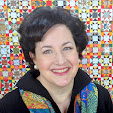March 7, 2012
Quilters Newsletter published a lesson, Anita's Unbiased Block, in the April/May 2012 issue The image below is of their online web extraI met the the editor, Joli Hines Sayasane, and Susan Geddes, the art director, in Houston last fall. Eventually I collaborated with the then managing editor, Dana Jones. I learned that Dana and I almost crossed paths many times over when she lived in New York. I own just about every issue of QN that has been published and I cherish them. I used to think the last quilting renaissance began with the Whitney Museum of American Art's 1971 exhibition "Abstract Design in American Quilts" curated by Jonathan Holstein and Gail van der Hoof. Now I'm thinking it began with the publication by Bonnie Leman of her Quilter's Newsletter in 1969.
I'm also thinking about the time my husband walked past me while I was watching a video interview from the University of Nebraska featuring Jonathan Holstein. My husband paused to remark about the Chinese chair that Holstein was sitting in. A moment later he turned back as he recognized Holstein. Oh he said, "Roy Lichtenstein took me to this man's apartment to look at quilts, but at the time, I didn't get it." That's another story...
I received a photograph today from the Berks Quilters Guild of Berks County, PA. from their recent meeting. Apparently they received a record number forty-eight BOMS. I'm thrilled to see the effects of so many varieties of stripe fabrics and to see that 48 blocks by different makers all turn out to be 10 ½ inch unfinished squares in part because of a ½ inch of interfacing. You can be sure that I am smiling. I'm biased but the blocks aren't.












